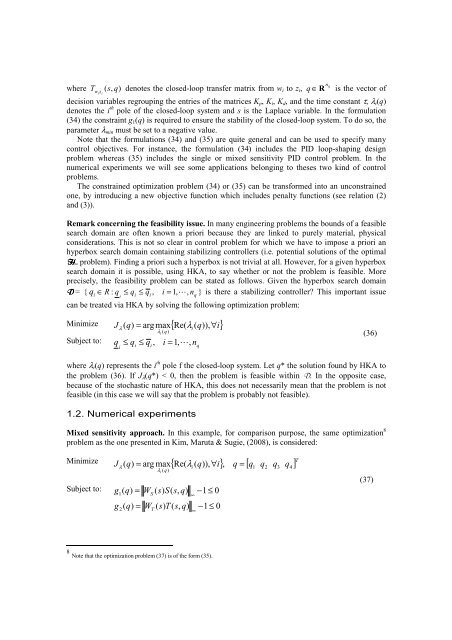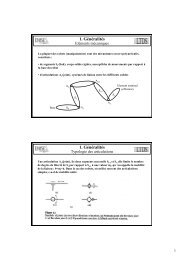q - Rosario Toscano - Free
q - Rosario Toscano - Free
q - Rosario Toscano - Free
Create successful ePaper yourself
Turn your PDF publications into a flip-book with our unique Google optimized e-Paper software.
q<br />
where Tw ( s,<br />
q)<br />
denotes the closed-loop transfer matrix from wi to zi, q ∈ R is the vector of<br />
izi<br />
decision variables regrouping the entries of the matrices Kp, Ki, Kd, and the time constant τ, λi(q)<br />
denotes the i th pole of the closed-loop system and s is the Laplace variable. In the formulation<br />
(34) the constraint g1(q) is required to ensure the stability of the closed-loop system. To do so, the<br />
parameter λmin must be set to a negative value.<br />
Note that the formulations (34) and (35) are quite general and can be used to specify many<br />
control objectives. For instance, the formulation (34) includes the PID loop-shaping design<br />
problem whereas (35) includes the single or mixed sensitivity PID control problem. In the<br />
numerical experiments we will see some applications belonging to theses two kind of control<br />
problems.<br />
The constrained optimization problem (34) or (35) can be transformed into an unconstrained<br />
one, by introducing a new objective function which includes penalty functions (see relation (2)<br />
and (3)).<br />
Remark concerning the feasibility issue. In many engineering problems the bounds of a feasible<br />
search domain are often known a priori because they are linked to purely material, physical<br />
considerations. This is not so clear in control problem for which we have to impose a priori an<br />
hyperbox search domain containing stabilizing controllers (i.e. potential solutions of the optimal<br />
HHHH∞ problem). Finding a priori such a hyperbox is not trivial at all. However, for a given hyperbox<br />
search domain it is possible, using HKA, to say whether or not the problem is feasible. More<br />
precisely, the feasibility problem can be stated as follows. Given the hyperbox search domain<br />
DDDD = { q i ∈ R : q ≤ q<br />
i i ≤ qi<br />
, i = 1,<br />
L,<br />
nq<br />
} is there a stabilizing controller? This important issue<br />
can be treated via HKA by solving the following optimization problem:<br />
Minimize ( q)<br />
= arg max{<br />
Re( λ ( q)),<br />
∀i}<br />
Subject to:<br />
J λ<br />
i<br />
λi<br />
( q)<br />
q ≤ q ≤ q , i = 1,<br />
L,<br />
n<br />
i<br />
i<br />
i<br />
q<br />
where λi(q) represents the i th pole f the closed-loop system. Let q* the solution found by HKA to<br />
the problem (36). If Jλ(q*) < 0, then the problem is feasible within D. In the opposite case,<br />
because of the stochastic nature of HKA, this does not necessarily mean that the problem is not<br />
feasible (in this case we will say that the problem is probably not feasible).<br />
1.2. Numerical experiments<br />
Mixed sensitivity approach. In this example, for comparison purpose, the same optimization 8<br />
problem as the one presented in Kim, Maruta & Sugie, (2008), is considered:<br />
Minimize { } [ ] T<br />
Subject to:<br />
J ( q)<br />
= arg max Re( λ ( q)),<br />
∀i<br />
, q = q<br />
λ<br />
1<br />
2<br />
λi<br />
( q)<br />
g ( q)<br />
= W ( s)<br />
S(<br />
s,<br />
q)<br />
g ( q)<br />
= W ( s)<br />
T ( s,<br />
q)<br />
i<br />
∞<br />
∞<br />
−1<br />
≤ 0<br />
−1<br />
≤ 0<br />
8 Note that the optimization problem (37) is of the form (35).<br />
S<br />
T<br />
1<br />
q<br />
2<br />
q<br />
3<br />
q<br />
4<br />
n<br />
(36)<br />
(37)



